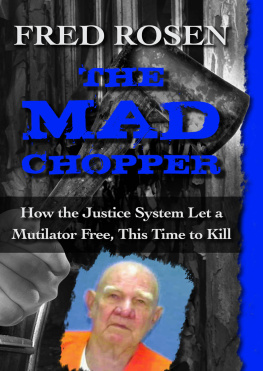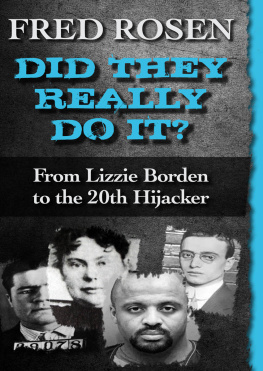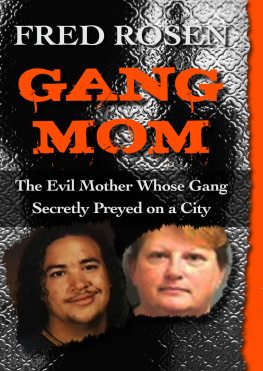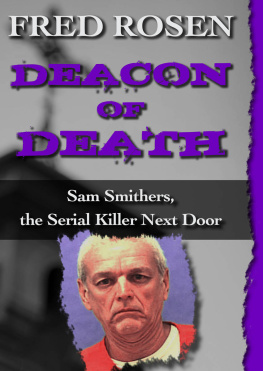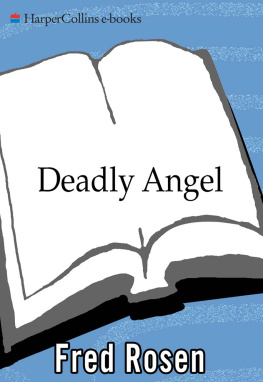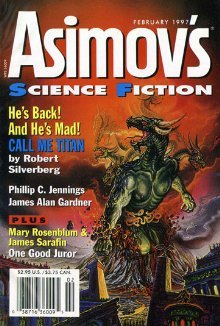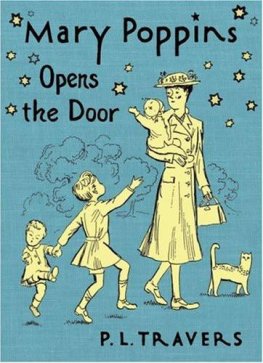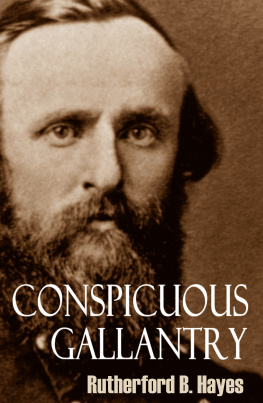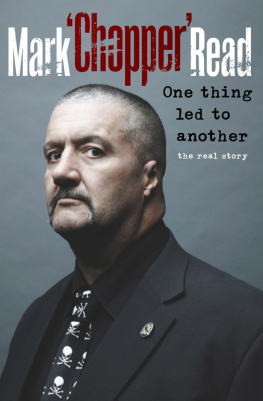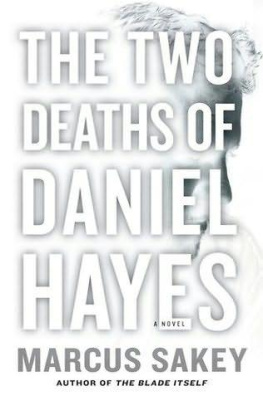The Mad Chopper
How the Justice System Let a Mutilator Free, This Time to Kill
Fred Rosen
In memoriam:
Wayde Preston, Doug McClure, John Russell, Chuck Connors and Roy Rogers.
A Word About Sources
The story you are about to read is true. It spans two states and twenty years.
Interviews, official documents, statements to police and reporters, as well as newspaper articles, have all been used in the writing of this book. In the event that two participants offer differing, noncorroborating accounts of the same event, the author has used his journalistic prerogative to choose which version to present.
Dialogue has been extracted from the authors interviews, court documents, Singletons murder trial, and newspaper articles. Some scenes have been dramatically recreated to portray episodes that occurred. A few scenes might be presented out of chronological order to simplify the narrative. Likewise, the Singleton investigation involved many police officers and for the sake of clarity, the story is presented principally through the eyes of the lead police officers.
The author has chosen to change the names of some individuals to afford them privacy. Any similarity between those fictitious names used and those of living persons or dead is purely coincidental.
Id like to thank Captain Richard Breshears of the Stanislaus County Sheriffs Office in California, and Vilma Bean of the Hillsborough County Sheriffs Office in Florida for their invaluable assistance in writing this book, and Kensington Editor-in-chief Paul Dinas for his patience and guidance.
PROLOGUE
Tampa, Florida
February 9, 1997
The 911 call came through at 6:07 P.M .
Hes beating a woman, hes beating a woman, the caller said frantically.
Where is this, sir, and
Listen, we just went up to the house and there was this guy inside and he was beating this woman.
Whats your name, sir? asked the operator, speaking in the rational tone she had been trained to use when someone half crazy with fear called.
My names Gene Reynolds. And its that guy, that guy
What guy sir? Take your time, just calm down. Her training included calming people down when they were excited.
Okay, okay, and Gene slowed down a little. Okay, now I dont know what the deal is, but the person that lives in that house is the same guy that cut that girls arms off, that fifteen-year-old in California.
The operator didnt know what the hell he was talking about, but she still didnt have an address. After Reynolds gave it to her, she said the police would be there immediately. That was another thing 911 operators were trained to do. Say that the cops would be there immediately.
Hillsborough County, of which Tampa is a part, claims that the average response time to emergency calls is 9.1 minutes. It took thirty-four minutes for the first police car, with one Hillsborough County deputy, to arrive at the address. The cops would later explain the delay by saying it was shift-change time and it was rush hour traffic. Besides, no matter how fast they had arrived, the girl would have been dead anyway. Or so they would claim.
The murder had occurred in Orient Park, a neighborhood best described as the armpit of Tampa. Rundown, one-family houses lined the narrow streets, but the one Deputy Paul Robbins stopped at was nicer than the rest. It looked as though someone had put a lot of money into renovating it.
Robbins didnt know it, but he was right. Ninety grand had been sunk into what had once been a rundown bungalow to make it what it was now, a jewel of a house, the nicest in the neighborhood, which literally shone in the blue light of dusk. But Robbins didnt really care about its appearance. His eyes were trained on the vicious-looking Rottweiler that was guarding the door. It wasnt on a leash and it was barking its head off.
Stu Simon, who lived across the street, heard the barking and came out on his porch. He saw the dog barking and the police car parked in front of the house and immediately knew it was big trouble. Stu quickly walked across the street.
Ill tie Kayla up, officer, he said and approached the dog without any fear He tied her to the front fence and turned back to the cop.
We have a report of a domestic disturbance here, said Robbins.
Stu went up to the front door and knocked without hesitation.
Bill, the laws here, he said and knocked again.
The door was answered by a naked man covered with blood and wearing a condom. He was staggering as though he was drunk. Before he could say anything, the phone rang. He didnt seem to hear it. Bill always responded quickly to phone calls, Stu thought Bill, the phones ringing, Stu said gently.
The naked man went back into the house to answer it. Hand on his weapon, Robbins hesitantly followed him.
On a sofa at the other side of the narrow room the deputy saw the body of a woman. He went over to look and saw that she was covered in blood. She was dead. He looked up. The naked man was standing over him. He had a mournful look on his face and he said nothing.
What happened here? Robbins asked.
The man still said nothing. Robbins reached to the back of his belt, pulled off his cuffs, then spun the guy around.
Youre under arrest, he said, then added, for murder.
There was no need to frisk him.
PART ONE
The Mutilation
PART TWO
No Mans Land
PART THREE
Retribution
Chapter One
Berkeley, California
1978
The University of California at Berkeley is situated across the bay from San Francisco. A hotbed of radicalism in the 1960s, Berkeley, as the school was commonly known, clung to its radical reputation in the 1970s like a baby to its bottle.
The reputation fed the schools popularity and as such, its radical past, and present, provided a haven for those free-thinking academics who would have found it difficult to teach at most other universities. Students knew this, and those who wanted to be taught in a different way, free from the rhetoric and mores of contemporary society, still flocked to Berkeley. Enrollment was also helped by the fact that it was a great party school.
There werent too many places more interesting than the San Francisco Bay area. The heavy gay population, and the strip clubs that dotted the landscape contributed to the feeling that San Francisco was a place where you could and would find anything and everything. At Berkeley itself, drug use was still de rigueur if you were a student, and sexywell, all you had to do was look around at the sun-kissed bodies of men and women in tank tops and shorts, and if you didnt get turned on, then you were surely asexual.
This casual attitude toward sex, and the free-form education structure, contributed to an attitude of permissiveness that blanketed the campus. The last thing on anyones mind was danger. How could it be, if you spent most of your time partying? But in Berkeley, there was a corner where crime, major crime, was just waiting to happen.
The students called it Hitchhikers Corner on University Avenue. It was the place you went to in order to hitch a ride anywhere in the state. Often it would be a student whod pick you up. But there wasnt anything to stop anyone else from driving there, someone who wanted to take advantage of, say, some young coed, or some runaway who happened to float into Berkeley. Luckily, nothing major had ever happened that anyone could remember.
Sure, maybe some kid had gotten picked up by some weirdo and been roughed up a bit, and maybe some poor girl had been picked up by some frustrated suburban husband who had forced himself on her. But for the most part, everyone who didnt have a car just hitched and didnt think twice about his or her safety.

